GSBS6001 Managing Uncertainty: Rationality vs Reality Essay, 2018
VerifiedAdded on 2023/05/29
|8
|2098
|91
Essay
AI Summary
This essay critically examines the dichotomy between rational and non-rational decision-making models in management, particularly under conditions of uncertainty. It argues that while rational decision-making aims for optimal choices through structured processes, it often proves unrealistic due to time constraints, emotional influences, and incomplete information. Non-rational decision-making, encompassing satisficing, incrementalism, and intuition, offers a more practical approach for managers facing real-world complexities, despite its inherent risks of bias and suboptimal outcomes. The essay concludes that while both models have limitations, non-rational decision-making is often more suitable for timely and resource-efficient managerial decisions. Desklib provides access to similar essays and solved assignments for students.
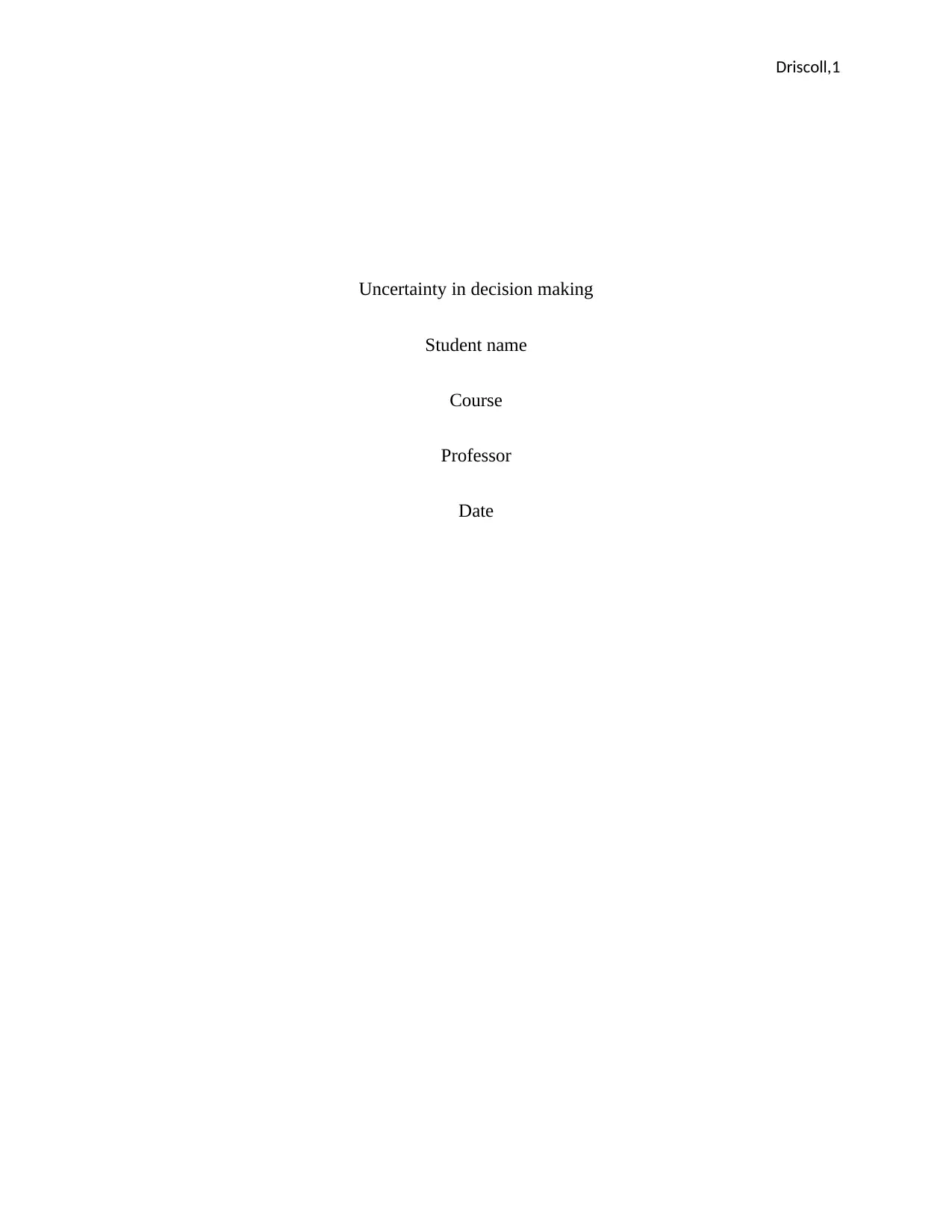
Driscoll,1
Uncertainty in decision making
Student name
Course
Professor
Date
Uncertainty in decision making
Student name
Course
Professor
Date
Paraphrase This Document
Need a fresh take? Get an instant paraphrase of this document with our AI Paraphraser
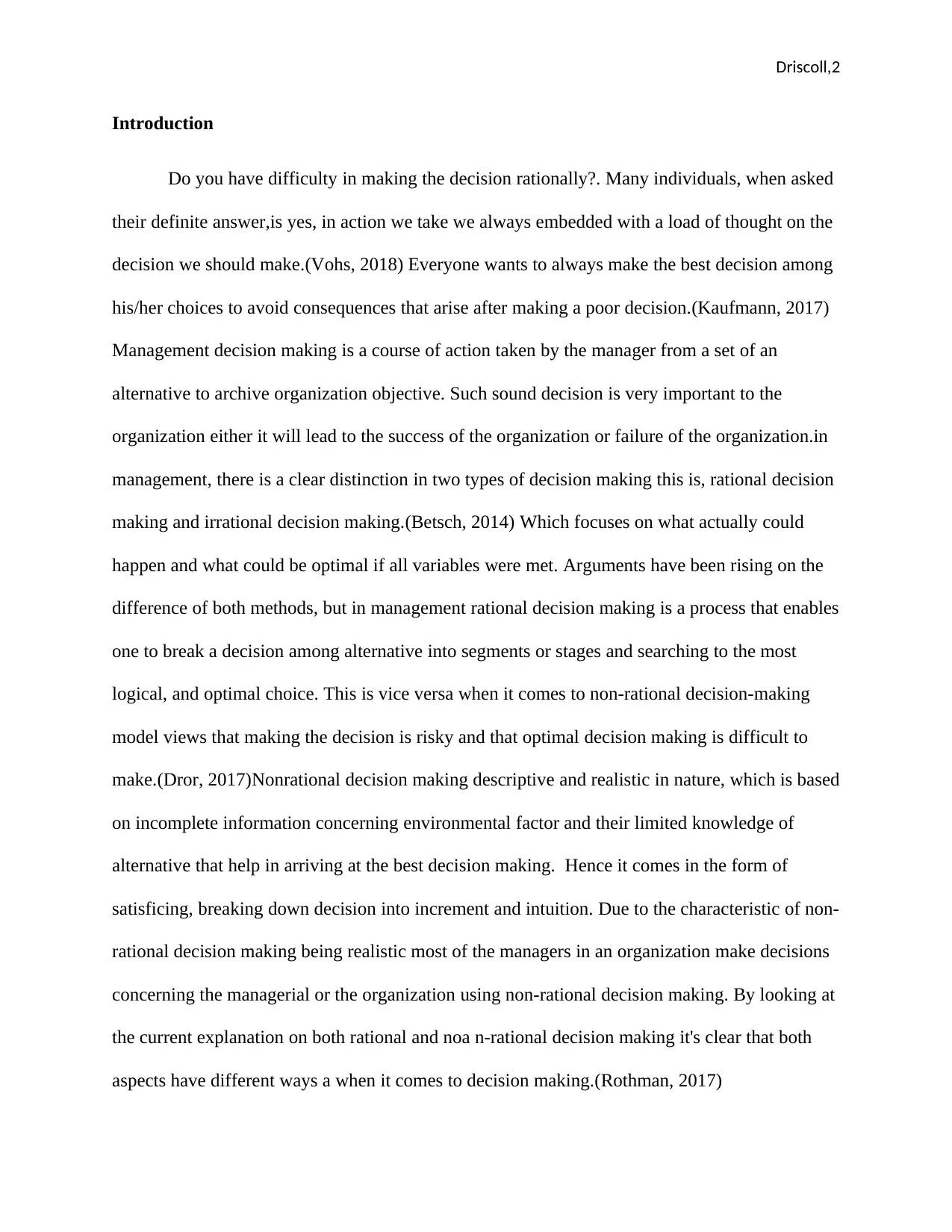
Driscoll,2
Introduction
Do you have difficulty in making the decision rationally?. Many individuals, when asked
their definite answer,is yes, in action we take we always embedded with a load of thought on the
decision we should make.(Vohs, 2018) Everyone wants to always make the best decision among
his/her choices to avoid consequences that arise after making a poor decision.(Kaufmann, 2017)
Management decision making is a course of action taken by the manager from a set of an
alternative to archive organization objective. Such sound decision is very important to the
organization either it will lead to the success of the organization or failure of the organization.in
management, there is a clear distinction in two types of decision making this is, rational decision
making and irrational decision making.(Betsch, 2014) Which focuses on what actually could
happen and what could be optimal if all variables were met. Arguments have been rising on the
difference of both methods, but in management rational decision making is a process that enables
one to break a decision among alternative into segments or stages and searching to the most
logical, and optimal choice. This is vice versa when it comes to non-rational decision-making
model views that making the decision is risky and that optimal decision making is difficult to
make.(Dror, 2017)Nonrational decision making descriptive and realistic in nature, which is based
on incomplete information concerning environmental factor and their limited knowledge of
alternative that help in arriving at the best decision making. Hence it comes in the form of
satisficing, breaking down decision into increment and intuition. Due to the characteristic of non-
rational decision making being realistic most of the managers in an organization make decisions
concerning the managerial or the organization using non-rational decision making. By looking at
the current explanation on both rational and noa n-rational decision making it's clear that both
aspects have different ways a when it comes to decision making.(Rothman, 2017)
Introduction
Do you have difficulty in making the decision rationally?. Many individuals, when asked
their definite answer,is yes, in action we take we always embedded with a load of thought on the
decision we should make.(Vohs, 2018) Everyone wants to always make the best decision among
his/her choices to avoid consequences that arise after making a poor decision.(Kaufmann, 2017)
Management decision making is a course of action taken by the manager from a set of an
alternative to archive organization objective. Such sound decision is very important to the
organization either it will lead to the success of the organization or failure of the organization.in
management, there is a clear distinction in two types of decision making this is, rational decision
making and irrational decision making.(Betsch, 2014) Which focuses on what actually could
happen and what could be optimal if all variables were met. Arguments have been rising on the
difference of both methods, but in management rational decision making is a process that enables
one to break a decision among alternative into segments or stages and searching to the most
logical, and optimal choice. This is vice versa when it comes to non-rational decision-making
model views that making the decision is risky and that optimal decision making is difficult to
make.(Dror, 2017)Nonrational decision making descriptive and realistic in nature, which is based
on incomplete information concerning environmental factor and their limited knowledge of
alternative that help in arriving at the best decision making. Hence it comes in the form of
satisficing, breaking down decision into increment and intuition. Due to the characteristic of non-
rational decision making being realistic most of the managers in an organization make decisions
concerning the managerial or the organization using non-rational decision making. By looking at
the current explanation on both rational and noa n-rational decision making it's clear that both
aspects have different ways a when it comes to decision making.(Rothman, 2017)
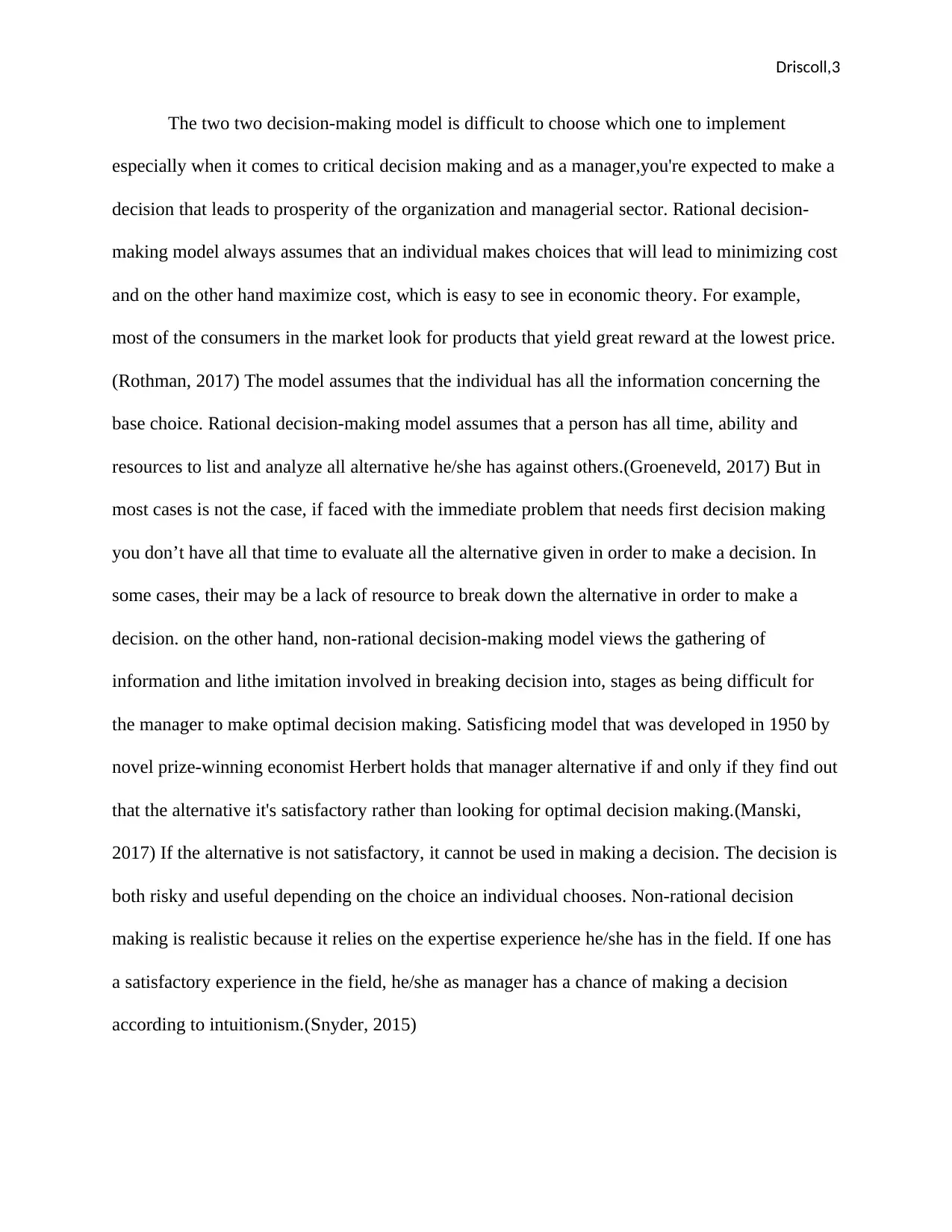
Driscoll,3
The two two decision-making model is difficult to choose which one to implement
especially when it comes to critical decision making and as a manager,you're expected to make a
decision that leads to prosperity of the organization and managerial sector. Rational decision-
making model always assumes that an individual makes choices that will lead to minimizing cost
and on the other hand maximize cost, which is easy to see in economic theory. For example,
most of the consumers in the market look for products that yield great reward at the lowest price.
(Rothman, 2017) The model assumes that the individual has all the information concerning the
base choice. Rational decision-making model assumes that a person has all time, ability and
resources to list and analyze all alternative he/she has against others.(Groeneveld, 2017) But in
most cases is not the case, if faced with the immediate problem that needs first decision making
you don’t have all that time to evaluate all the alternative given in order to make a decision. In
some cases, their may be a lack of resource to break down the alternative in order to make a
decision. on the other hand, non-rational decision-making model views the gathering of
information and lithe imitation involved in breaking decision into, stages as being difficult for
the manager to make optimal decision making. Satisficing model that was developed in 1950 by
novel prize-winning economist Herbert holds that manager alternative if and only if they find out
that the alternative it's satisfactory rather than looking for optimal decision making.(Manski,
2017) If the alternative is not satisfactory, it cannot be used in making a decision. The decision is
both risky and useful depending on the choice an individual chooses. Non-rational decision
making is realistic because it relies on the expertise experience he/she has in the field. If one has
a satisfactory experience in the field, he/she as manager has a chance of making a decision
according to intuitionism.(Snyder, 2015)
The two two decision-making model is difficult to choose which one to implement
especially when it comes to critical decision making and as a manager,you're expected to make a
decision that leads to prosperity of the organization and managerial sector. Rational decision-
making model always assumes that an individual makes choices that will lead to minimizing cost
and on the other hand maximize cost, which is easy to see in economic theory. For example,
most of the consumers in the market look for products that yield great reward at the lowest price.
(Rothman, 2017) The model assumes that the individual has all the information concerning the
base choice. Rational decision-making model assumes that a person has all time, ability and
resources to list and analyze all alternative he/she has against others.(Groeneveld, 2017) But in
most cases is not the case, if faced with the immediate problem that needs first decision making
you don’t have all that time to evaluate all the alternative given in order to make a decision. In
some cases, their may be a lack of resource to break down the alternative in order to make a
decision. on the other hand, non-rational decision-making model views the gathering of
information and lithe imitation involved in breaking decision into, stages as being difficult for
the manager to make optimal decision making. Satisficing model that was developed in 1950 by
novel prize-winning economist Herbert holds that manager alternative if and only if they find out
that the alternative it's satisfactory rather than looking for optimal decision making.(Manski,
2017) If the alternative is not satisfactory, it cannot be used in making a decision. The decision is
both risky and useful depending on the choice an individual chooses. Non-rational decision
making is realistic because it relies on the expertise experience he/she has in the field. If one has
a satisfactory experience in the field, he/she as manager has a chance of making a decision
according to intuitionism.(Snyder, 2015)
⊘ This is a preview!⊘
Do you want full access?
Subscribe today to unlock all pages.

Trusted by 1+ million students worldwide
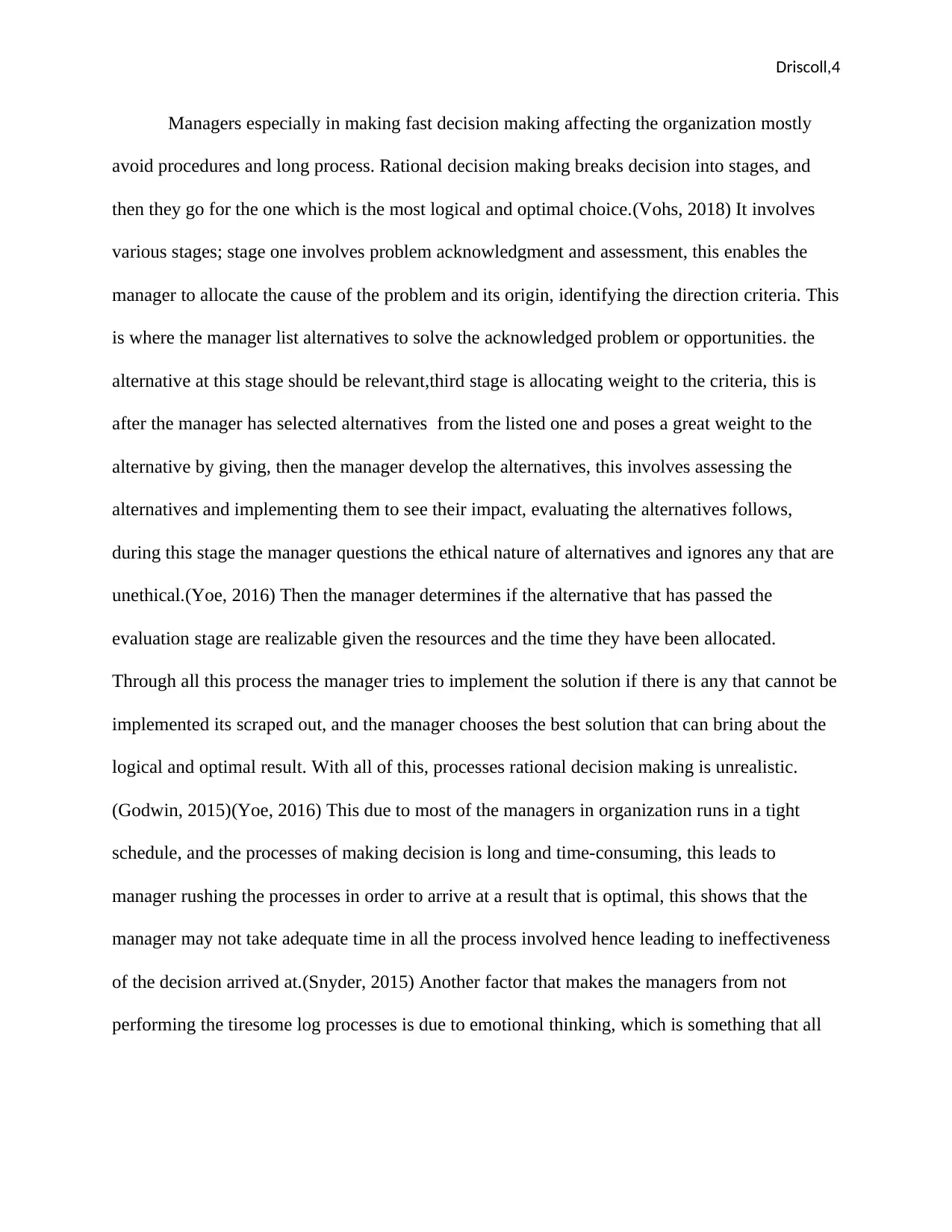
Driscoll,4
Managers especially in making fast decision making affecting the organization mostly
avoid procedures and long process. Rational decision making breaks decision into stages, and
then they go for the one which is the most logical and optimal choice.(Vohs, 2018) It involves
various stages; stage one involves problem acknowledgment and assessment, this enables the
manager to allocate the cause of the problem and its origin, identifying the direction criteria. This
is where the manager list alternatives to solve the acknowledged problem or opportunities. the
alternative at this stage should be relevant,third stage is allocating weight to the criteria, this is
after the manager has selected alternatives from the listed one and poses a great weight to the
alternative by giving, then the manager develop the alternatives, this involves assessing the
alternatives and implementing them to see their impact, evaluating the alternatives follows,
during this stage the manager questions the ethical nature of alternatives and ignores any that are
unethical.(Yoe, 2016) Then the manager determines if the alternative that has passed the
evaluation stage are realizable given the resources and the time they have been allocated.
Through all this process the manager tries to implement the solution if there is any that cannot be
implemented its scraped out, and the manager chooses the best solution that can bring about the
logical and optimal result. With all of this, processes rational decision making is unrealistic.
(Godwin, 2015)(Yoe, 2016) This due to most of the managers in organization runs in a tight
schedule, and the processes of making decision is long and time-consuming, this leads to
manager rushing the processes in order to arrive at a result that is optimal, this shows that the
manager may not take adequate time in all the process involved hence leading to ineffectiveness
of the decision arrived at.(Snyder, 2015) Another factor that makes the managers from not
performing the tiresome log processes is due to emotional thinking, which is something that all
Managers especially in making fast decision making affecting the organization mostly
avoid procedures and long process. Rational decision making breaks decision into stages, and
then they go for the one which is the most logical and optimal choice.(Vohs, 2018) It involves
various stages; stage one involves problem acknowledgment and assessment, this enables the
manager to allocate the cause of the problem and its origin, identifying the direction criteria. This
is where the manager list alternatives to solve the acknowledged problem or opportunities. the
alternative at this stage should be relevant,third stage is allocating weight to the criteria, this is
after the manager has selected alternatives from the listed one and poses a great weight to the
alternative by giving, then the manager develop the alternatives, this involves assessing the
alternatives and implementing them to see their impact, evaluating the alternatives follows,
during this stage the manager questions the ethical nature of alternatives and ignores any that are
unethical.(Yoe, 2016) Then the manager determines if the alternative that has passed the
evaluation stage are realizable given the resources and the time they have been allocated.
Through all this process the manager tries to implement the solution if there is any that cannot be
implemented its scraped out, and the manager chooses the best solution that can bring about the
logical and optimal result. With all of this, processes rational decision making is unrealistic.
(Godwin, 2015)(Yoe, 2016) This due to most of the managers in organization runs in a tight
schedule, and the processes of making decision is long and time-consuming, this leads to
manager rushing the processes in order to arrive at a result that is optimal, this shows that the
manager may not take adequate time in all the process involved hence leading to ineffectiveness
of the decision arrived at.(Snyder, 2015) Another factor that makes the managers from not
performing the tiresome log processes is due to emotional thinking, which is something that all
Paraphrase This Document
Need a fresh take? Get an instant paraphrase of this document with our AI Paraphraser
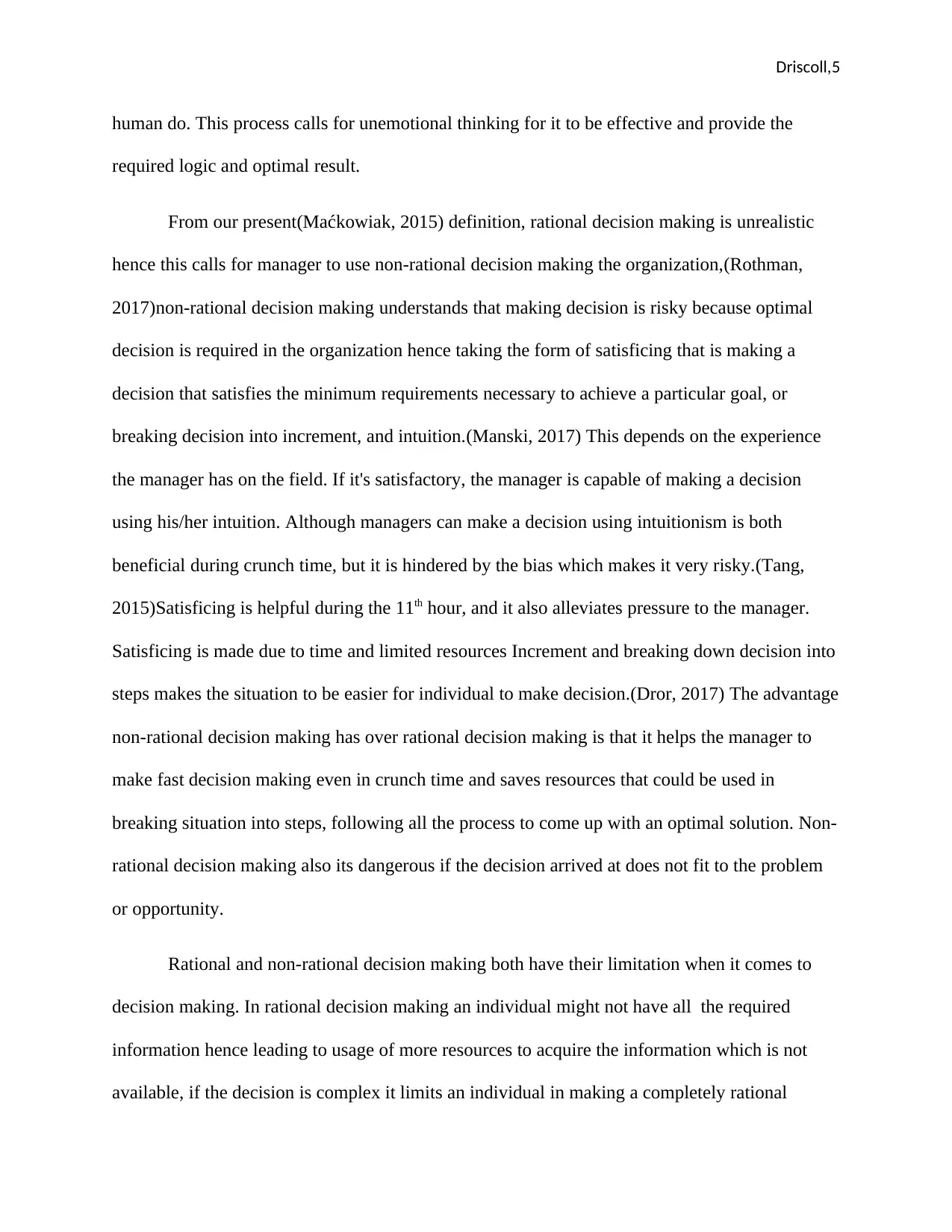
Driscoll,5
human do. This process calls for unemotional thinking for it to be effective and provide the
required logic and optimal result.
From our present(Maćkowiak, 2015) definition, rational decision making is unrealistic
hence this calls for manager to use non-rational decision making the organization,(Rothman,
2017)non-rational decision making understands that making decision is risky because optimal
decision is required in the organization hence taking the form of satisficing that is making a
decision that satisfies the minimum requirements necessary to achieve a particular goal, or
breaking decision into increment, and intuition.(Manski, 2017) This depends on the experience
the manager has on the field. If it's satisfactory, the manager is capable of making a decision
using his/her intuition. Although managers can make a decision using intuitionism is both
beneficial during crunch time, but it is hindered by the bias which makes it very risky.(Tang,
2015)Satisficing is helpful during the 11th hour, and it also alleviates pressure to the manager.
Satisficing is made due to time and limited resources Increment and breaking down decision into
steps makes the situation to be easier for individual to make decision.(Dror, 2017) The advantage
non-rational decision making has over rational decision making is that it helps the manager to
make fast decision making even in crunch time and saves resources that could be used in
breaking situation into steps, following all the process to come up with an optimal solution. Non-
rational decision making also its dangerous if the decision arrived at does not fit to the problem
or opportunity.
Rational and non-rational decision making both have their limitation when it comes to
decision making. In rational decision making an individual might not have all the required
information hence leading to usage of more resources to acquire the information which is not
available, if the decision is complex it limits an individual in making a completely rational
human do. This process calls for unemotional thinking for it to be effective and provide the
required logic and optimal result.
From our present(Maćkowiak, 2015) definition, rational decision making is unrealistic
hence this calls for manager to use non-rational decision making the organization,(Rothman,
2017)non-rational decision making understands that making decision is risky because optimal
decision is required in the organization hence taking the form of satisficing that is making a
decision that satisfies the minimum requirements necessary to achieve a particular goal, or
breaking decision into increment, and intuition.(Manski, 2017) This depends on the experience
the manager has on the field. If it's satisfactory, the manager is capable of making a decision
using his/her intuition. Although managers can make a decision using intuitionism is both
beneficial during crunch time, but it is hindered by the bias which makes it very risky.(Tang,
2015)Satisficing is helpful during the 11th hour, and it also alleviates pressure to the manager.
Satisficing is made due to time and limited resources Increment and breaking down decision into
steps makes the situation to be easier for individual to make decision.(Dror, 2017) The advantage
non-rational decision making has over rational decision making is that it helps the manager to
make fast decision making even in crunch time and saves resources that could be used in
breaking situation into steps, following all the process to come up with an optimal solution. Non-
rational decision making also its dangerous if the decision arrived at does not fit to the problem
or opportunity.
Rational and non-rational decision making both have their limitation when it comes to
decision making. In rational decision making an individual might not have all the required
information hence leading to usage of more resources to acquire the information which is not
available, if the decision is complex it limits an individual in making a completely rational
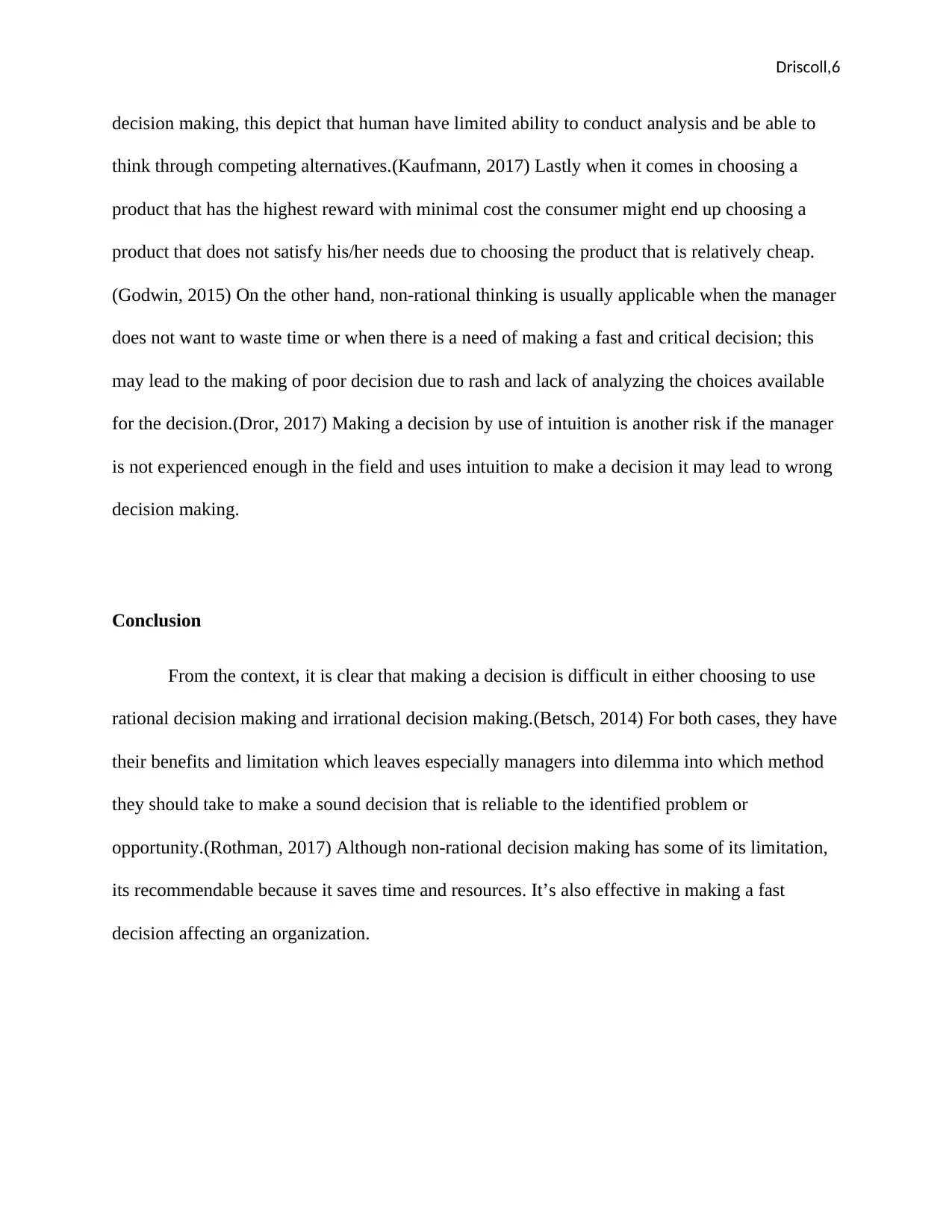
Driscoll,6
decision making, this depict that human have limited ability to conduct analysis and be able to
think through competing alternatives.(Kaufmann, 2017) Lastly when it comes in choosing a
product that has the highest reward with minimal cost the consumer might end up choosing a
product that does not satisfy his/her needs due to choosing the product that is relatively cheap.
(Godwin, 2015) On the other hand, non-rational thinking is usually applicable when the manager
does not want to waste time or when there is a need of making a fast and critical decision; this
may lead to the making of poor decision due to rash and lack of analyzing the choices available
for the decision.(Dror, 2017) Making a decision by use of intuition is another risk if the manager
is not experienced enough in the field and uses intuition to make a decision it may lead to wrong
decision making.
Conclusion
From the context, it is clear that making a decision is difficult in either choosing to use
rational decision making and irrational decision making.(Betsch, 2014) For both cases, they have
their benefits and limitation which leaves especially managers into dilemma into which method
they should take to make a sound decision that is reliable to the identified problem or
opportunity.(Rothman, 2017) Although non-rational decision making has some of its limitation,
its recommendable because it saves time and resources. It’s also effective in making a fast
decision affecting an organization.
decision making, this depict that human have limited ability to conduct analysis and be able to
think through competing alternatives.(Kaufmann, 2017) Lastly when it comes in choosing a
product that has the highest reward with minimal cost the consumer might end up choosing a
product that does not satisfy his/her needs due to choosing the product that is relatively cheap.
(Godwin, 2015) On the other hand, non-rational thinking is usually applicable when the manager
does not want to waste time or when there is a need of making a fast and critical decision; this
may lead to the making of poor decision due to rash and lack of analyzing the choices available
for the decision.(Dror, 2017) Making a decision by use of intuition is another risk if the manager
is not experienced enough in the field and uses intuition to make a decision it may lead to wrong
decision making.
Conclusion
From the context, it is clear that making a decision is difficult in either choosing to use
rational decision making and irrational decision making.(Betsch, 2014) For both cases, they have
their benefits and limitation which leaves especially managers into dilemma into which method
they should take to make a sound decision that is reliable to the identified problem or
opportunity.(Rothman, 2017) Although non-rational decision making has some of its limitation,
its recommendable because it saves time and resources. It’s also effective in making a fast
decision affecting an organization.
⊘ This is a preview!⊘
Do you want full access?
Subscribe today to unlock all pages.

Trusted by 1+ million students worldwide
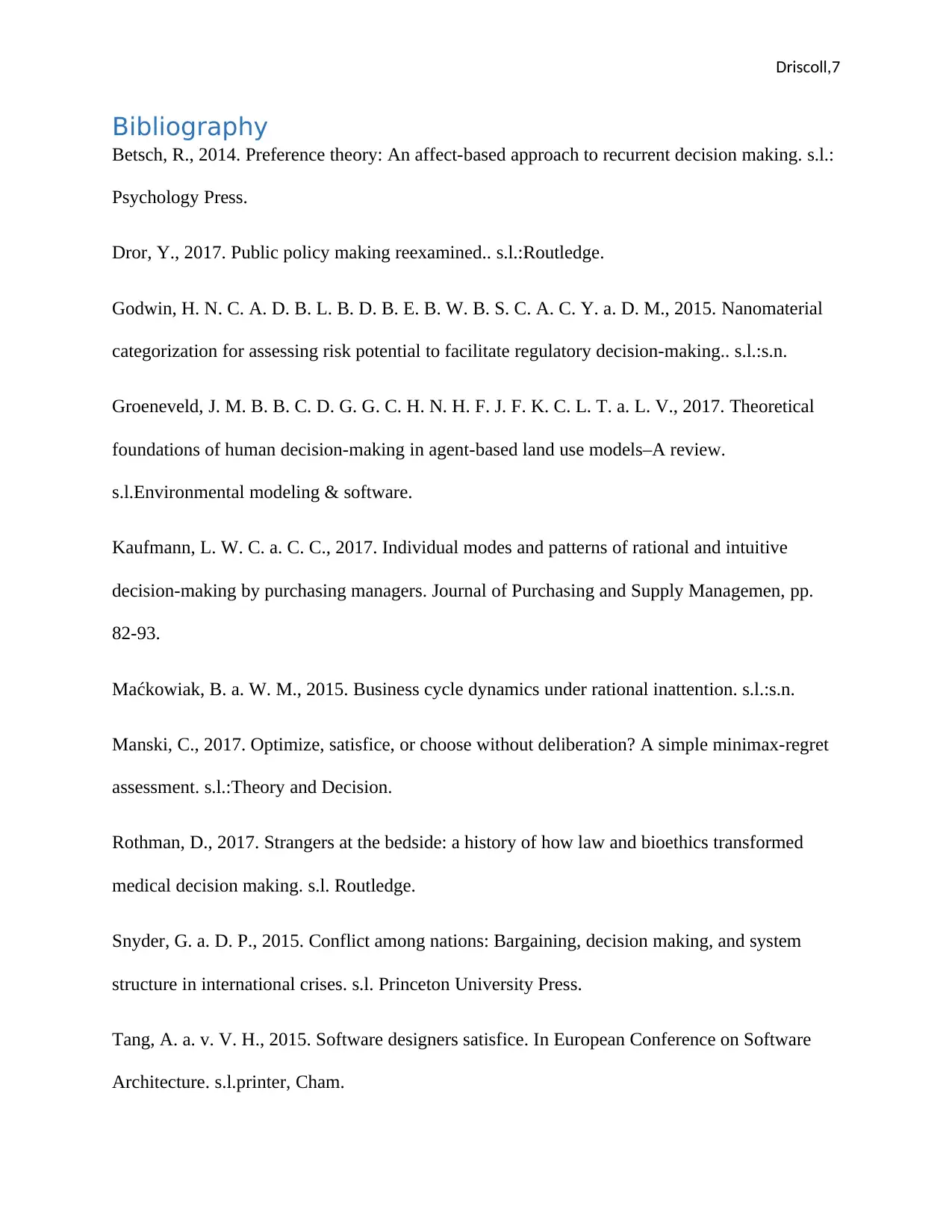
Driscoll,7
Bibliography
Betsch, R., 2014. Preference theory: An affect-based approach to recurrent decision making. s.l.:
Psychology Press.
Dror, Y., 2017. Public policy making reexamined.. s.l.:Routledge.
Godwin, H. N. C. A. D. B. L. B. D. B. E. B. W. B. S. C. A. C. Y. a. D. M., 2015. Nanomaterial
categorization for assessing risk potential to facilitate regulatory decision-making.. s.l.:s.n.
Groeneveld, J. M. B. B. C. D. G. G. C. H. N. H. F. J. F. K. C. L. T. a. L. V., 2017. Theoretical
foundations of human decision-making in agent-based land use models–A review.
s.l.Environmental modeling & software.
Kaufmann, L. W. C. a. C. C., 2017. Individual modes and patterns of rational and intuitive
decision-making by purchasing managers. Journal of Purchasing and Supply Managemen, pp.
82-93.
Maćkowiak, B. a. W. M., 2015. Business cycle dynamics under rational inattention. s.l.:s.n.
Manski, C., 2017. Optimize, satisfice, or choose without deliberation? A simple minimax-regret
assessment. s.l.:Theory and Decision.
Rothman, D., 2017. Strangers at the bedside: a history of how law and bioethics transformed
medical decision making. s.l. Routledge.
Snyder, G. a. D. P., 2015. Conflict among nations: Bargaining, decision making, and system
structure in international crises. s.l. Princeton University Press.
Tang, A. a. v. V. H., 2015. Software designers satisfice. In European Conference on Software
Architecture. s.l.printer, Cham.
Bibliography
Betsch, R., 2014. Preference theory: An affect-based approach to recurrent decision making. s.l.:
Psychology Press.
Dror, Y., 2017. Public policy making reexamined.. s.l.:Routledge.
Godwin, H. N. C. A. D. B. L. B. D. B. E. B. W. B. S. C. A. C. Y. a. D. M., 2015. Nanomaterial
categorization for assessing risk potential to facilitate regulatory decision-making.. s.l.:s.n.
Groeneveld, J. M. B. B. C. D. G. G. C. H. N. H. F. J. F. K. C. L. T. a. L. V., 2017. Theoretical
foundations of human decision-making in agent-based land use models–A review.
s.l.Environmental modeling & software.
Kaufmann, L. W. C. a. C. C., 2017. Individual modes and patterns of rational and intuitive
decision-making by purchasing managers. Journal of Purchasing and Supply Managemen, pp.
82-93.
Maćkowiak, B. a. W. M., 2015. Business cycle dynamics under rational inattention. s.l.:s.n.
Manski, C., 2017. Optimize, satisfice, or choose without deliberation? A simple minimax-regret
assessment. s.l.:Theory and Decision.
Rothman, D., 2017. Strangers at the bedside: a history of how law and bioethics transformed
medical decision making. s.l. Routledge.
Snyder, G. a. D. P., 2015. Conflict among nations: Bargaining, decision making, and system
structure in international crises. s.l. Princeton University Press.
Tang, A. a. v. V. H., 2015. Software designers satisfice. In European Conference on Software
Architecture. s.l.printer, Cham.
Paraphrase This Document
Need a fresh take? Get an instant paraphrase of this document with our AI Paraphraser
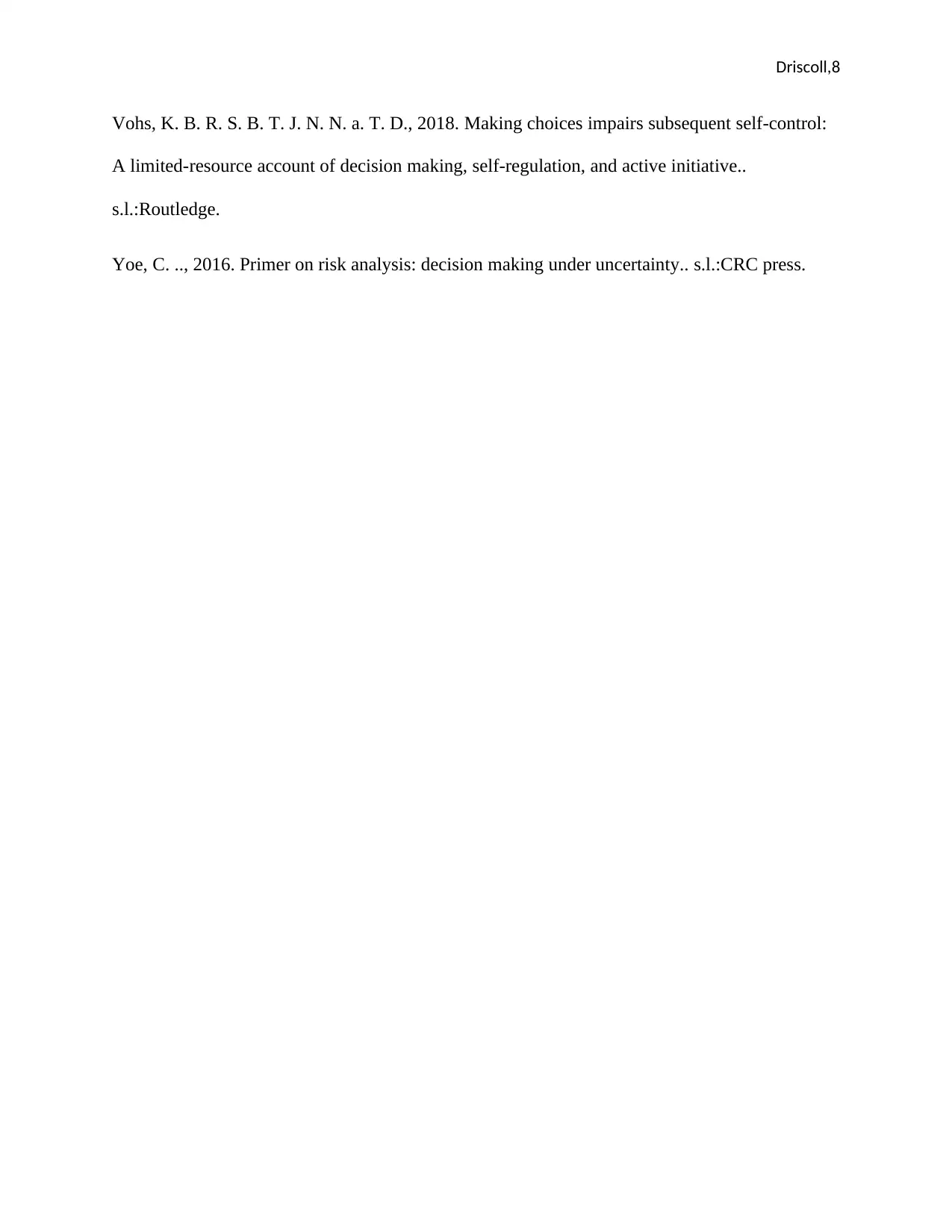
Driscoll,8
Vohs, K. B. R. S. B. T. J. N. N. a. T. D., 2018. Making choices impairs subsequent self-control:
A limited-resource account of decision making, self-regulation, and active initiative..
s.l.:Routledge.
Yoe, C. .., 2016. Primer on risk analysis: decision making under uncertainty.. s.l.:CRC press.
Vohs, K. B. R. S. B. T. J. N. N. a. T. D., 2018. Making choices impairs subsequent self-control:
A limited-resource account of decision making, self-regulation, and active initiative..
s.l.:Routledge.
Yoe, C. .., 2016. Primer on risk analysis: decision making under uncertainty.. s.l.:CRC press.
1 out of 8
Related Documents
Your All-in-One AI-Powered Toolkit for Academic Success.
+13062052269
info@desklib.com
Available 24*7 on WhatsApp / Email
![[object Object]](/_next/static/media/star-bottom.7253800d.svg)
Unlock your academic potential
Copyright © 2020–2025 A2Z Services. All Rights Reserved. Developed and managed by ZUCOL.




